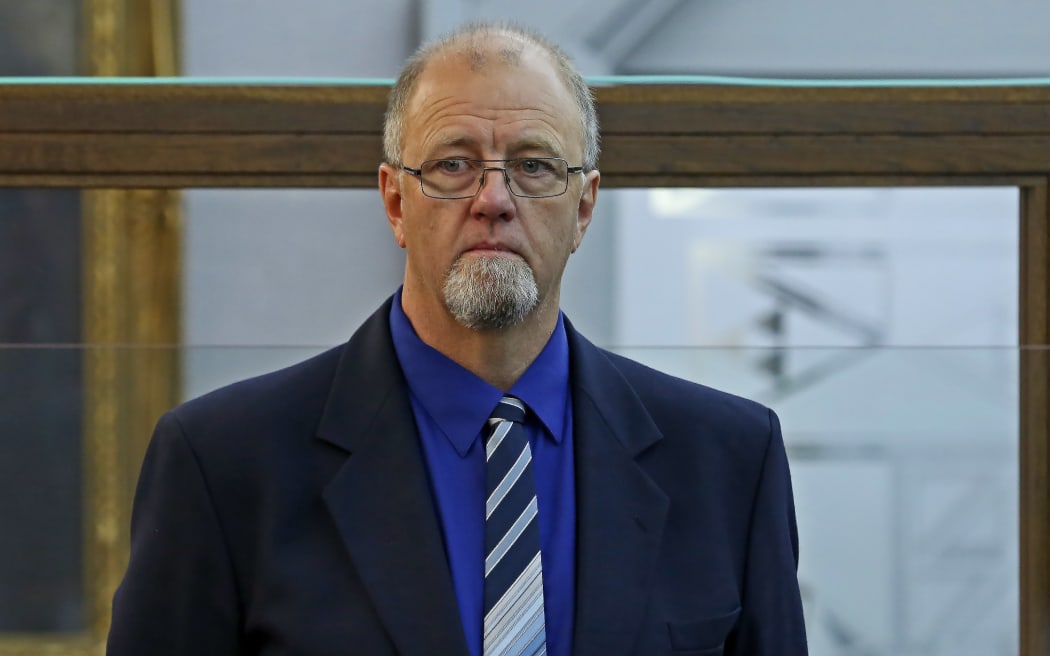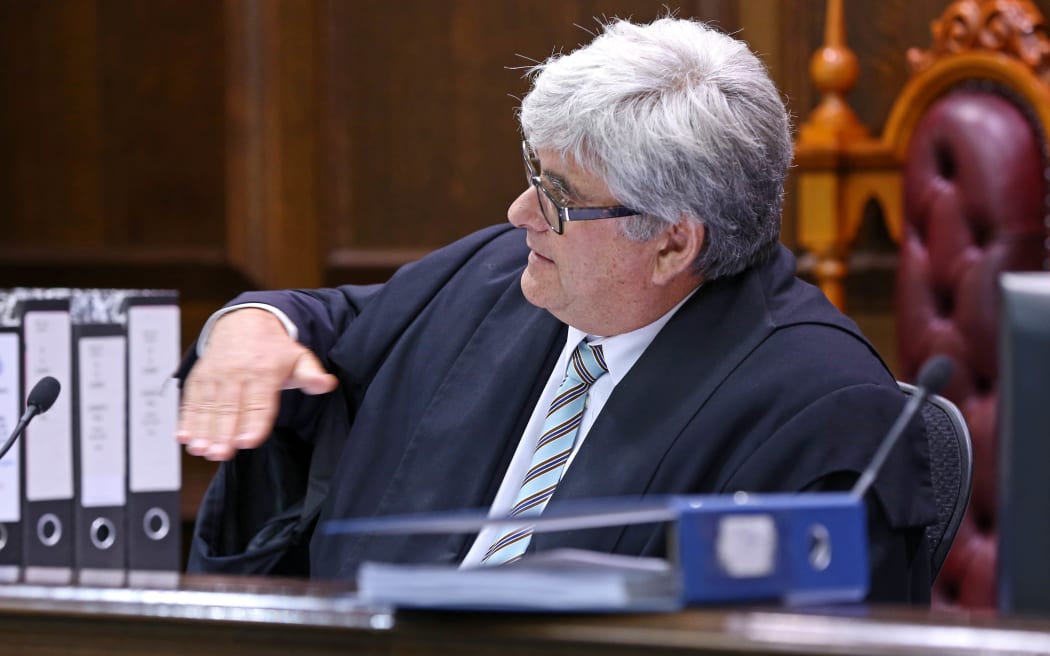The method used to identify human brain on Mark Lundy's shirt had never been used before, the High Court at Wellington has been told.

Mark Lundy in court today. Photo: RNZ / Alexander Robertson
Mark Lundy, 56, is accused of murdering his 38-year-old wife, Christine, and seven-year-old daughter, Amber, whose bodies were found in their Palmerston North home on 30 August 2000; the Crown claims Mr Lundy killed his wife for her insurance money and Amber because she saw what he was doing to her mother.
Key points from day 17:
Samples from smears found on a polo shirt belonging to Mr Lundy were taken to Laetitia Sijen, at the Netherlands Forensic Institute's (NFI) department of human biological traces, for species identification.
She told the High Court at Wellington she used a "brain plex" to conclude there was evidence of human brain in one of the smears. It was tested against brain tissue from seven animals, including chicken and cat, to reach the conclusion.
Earlier evidence has identified it as being from Mrs Lundy.
But defence lawyer David Hislop, QC, questioned Dr Sijen on the brain plex, saying it had never been used before and had not been subjected to the scrutiny of the scientific community.
Dr Sijen said it was the first time it had been used but that the strategy had been scrutinised three times.
"The forensic community is a community that challenges itself, because we need to know," she said.
Mr Hislop also questioned her on the error rate at the NFI, saying there were 114 human errors in 2012.
Dr Sijen said the NFI's department of human biological traces looked at about 45,000 products a year "so this is, in comparison to the number of DNA profiles that we generate, a relatively low number".
Judge questions UK forensic expert
Earlier today, Justice Simon France, who is presiding over the trial, asked a forensics expert whether her answer would ever be "no" over the risk of contamination.
The Crown is still presenting witnesses but defence witness Gillian Leak, a blood pattern analyst and crime scene expert, is giving evidence as she needs to return to Britain.
She has repeatedly been questioned about the risk of evidence contamination and has repeatedly said it could have happened.
An officer who sat in a car next to the person who first found the bodies and accompanied him to the police station - before overseeing the collection of Mr Lundy's car and handing the keys to another officer, who reached into the car to steer it and let the handbrake off - could have left matter in Mr Lundy's car, she said.
The matter could then found its way on to a polo shirt in a suit bag in the car.

British forensics expert Gillian Leak Photo: RNZ / Alexander Robertson
Justice France put it to Ms Leak that "everything has a potential risk".
"When you're dealing with exhibits and people movement at a crime scene ... would your answer ever be no," he asked.
Ms Leak agreed it would "probably never be fully no" because all options had to be considered.
Netherlands Forensic Institute forensics expert Laetitia Sijen told the court she tested tissue taken from two smears on Mr Lundy's polo shirt.
Those tests found no evidence of brain matter on the smaller smear but that it was "probable" the smear on the sleeve was brain.
Earlier evidence has identified it as being from Mrs Lundy.

Justice Simon France Photo: RNZ / Alexander Robertson
Earlier today, Ms Leak said smears of Mrs Lundy's blood found on a conservatory window could have got there from those investigating the death of her and her daughter.
There were no fingerprints in the blood found on a conservatory window at the Lundy family home but there were fabric marks in it; Crown prosecutor Philip Morgan suggested it indicated a gloved hand had tried to force the window.
But Ms Leak told the court she was not aware of anything to suggest the mark was made by a glove, rather that it was fabric covered in Mrs Lundy's blood.
The area where investigators got out of their protective gear was close to the window, which was slightly open in all the photos and video clips she had seen. Protective gear could be "bit of a balancing act" to get out of, and an investigator could have reached out to stop themselves falling over, she said.
Ms Leak yesterday watched a video of the crime scene and pointed out someone carrying a bag she assumed contained equipment known as a Polilight. That Polilight was used to examine Mr Lundy's car on 1 September, and Ms Leak raised the possibility of contamination from the crime scene to the car.
However, on cross examination Mr Morgan pointed out the fingerprint expert had not arrived at the scene until 31 August, and that the first use of the Polilight was on the car on 1 September.
"I assumed it and I made it quite clear that I assumed it," Ms Leak said, prompting Mr Morgan to say it was "less than desireable" for a forensic scientist to make assumptions.
He also questioned how there could have been any contamination - even if the Polilight had been at the house before being used to look at the car - when the only item found to have human tissue on it in the car was Mr Lundy's polo shirt, which was inside a suit bag; the Polilight was used only on the outside of the bag.
"... it didn't happen, did it," Mr Morgan said.
Today, defence lawyer Philip Hislop, QC, asked Ms Leak whether equipment bags should be inside a scene, whatever they contained.
She said they should always be left at the inner cordon of a crime scene to reduce the risk of contamination.
The trial is before Justice Simon France and a jury of seven men and five women.
* Clarification - For the avoidance of doubt, please note that Radio New Zealand reporter Sharon Lundy is no relation to Mark Lundy.





